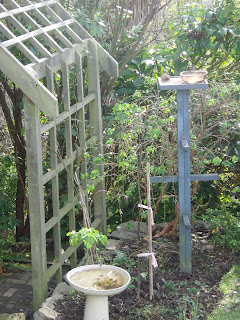I would almost go to say that winter was my favourite season in the garden. Winter means little weeding and a time to make big changes in your garden because it is easy to see what things are working and what things aren't. The best thing about winter however is the little surprises you find amongst the skeletons of other plants.
It closely resembles the large and taller Snowdrop although it is easy to disguinsh them as Snowflake has a green spot at the end of each petal. Like Snowdrop, they bloom in late winter and early spring. Snowflake thrives in milder climates where Snowdrop will not grow. It is one of the only bulbs that will thrive in heavy, moist soils in sun or shade. My Snowflakes suddenly appeared in one of my garden beds that is set into the clay hill and is dappled in shade.
Sometimes referred to as the "Christmas Rose" due to it's flowering time in the northern hemisphere and the "Lenten Rose" hellebores are the stars of a winter garden. It was a delight to see these flowers emerge this year because they were absent from my garden this time last year.
Nasturtiums grow best in semi-neglected areas. Just make sure it's well drained as they don't getting wet feet. I didn't plant my plant from seed it just grew one day. It sits below my balcony beside my jasmine and gets all day sun but not a lot of rain because it is sheltered by my house. Narsturtiums are annuals and apparently will die off after the first frosts but I we have had frosts in Dunedin this year and my plant doesn't look as though it is going anywhere anytime soon.

That gorgeous scent! My climbing jasmine started off as a big bush sitting just below my balcony. To one side of it was an ugly opening to the underneath of the house. In the past year I have been trying to train it onto some trellis in order to cover up that gaping mess. Finally it has begun to move and with another lot of summer growth should completely engulf it. Although the Jasmine probably flowers most prolifically in autumn it does put out flowers all through the year so is a great addition to any garden. Like the nasturtium is doesn’t like wet feet and loves plenty of sun.
Primula
Belonging to the family Primulaceae which includes a large number of species including primrose, auricula, cowslip and oxlip. I planted these seedlings back in February of March and had no idea what to expect. I actually thought they were never going to flower and then in May these beautiful pinks flowers appeared on tiny stalks. The planting suggestions said to plant in shade and so they border my stairs that are sheltered by the Pseudopanax and Kowhai tree standing in my garden. I am definitely adding this one too my list of favourites as I love beautiful flowering plants the can flower in amongst the shade.
Although there isn't much colour around in winter, the scarcity of green makes the garden lovely and airy, and at times it feels as though the garden is sunniest in winter. Dunedin provides beautiful crisp days and when there is no wind I think it is one of the best places in the world. However although I do enjoy wrapping up warm and walking around watching winter in my garden I feel as if I am forever waiting for the first signs of spring. Although spring is still a wee while away, clues that it is on its way are starting to emerge within my garden.
Tulip Bulb - I planted most of these in pots but put a few in the garden to. Big mistakes! I have forgotten where I planted them and the other day hoed them all up. Not ideal.
Hyacinth - I had one of these bulbs growing in a hyacinth vase, (instruction here) however it has already started to flower without properly forming a stem. So although it smells nice in my room it isn't pretty to look at. Will have to give it another go next year.
Unknown - It is like xmas waiting to open presents I just hope this one isn't coal.
Daffodil
Peony Rose Crowns
Last year I fell in love with peonys. My mother bought me a large bunch of them and they lasted for about a week and a half in a vase on my beside table. A few weeks later the peonys in my garden also bloomed and although the weren't as magnificent as the store bought ones I am hooked. Last year each of my peony plants produced 4-5 flowers which is a pretty bad turn out. So this year I am on the lookout on how to get more blooms. First on my list was to buy another few tubers so I can have different coloured blooms and did so through trademe. I then transplanted some of the tubers already in my garden to better suited spots (in full sun). I have also added a little fertiliser in the form of sheep pellets and now I am just playing the waiting game. Watch this space!




















































